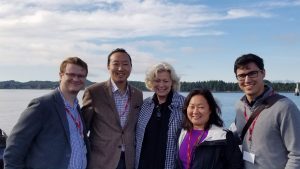California Chamber of Commerce Vice President of International Affairs Susanne Stirling joined private and public sector leaders from around the United States, and Canadian officials on a tour of the Canadian border for three days last week.
Stirling was invited by the Canadian Consulate in San Francisco to participate in the tour and visited Vancouver and Prince Rupert, both in British Columbia, from September 19–21.

Canada Border Tour Blog
Stirling chronicled the Canada Border Tour in a three-part blog for the CalChamber. In it, she outlines details regarding border security, supply chain logistics and free trade, and how she gained a deeper understanding of the different ports of entry into Canada (vehicle border checkpoints, seaports, rail stations, airports). This tour was first established after 9/11, and has grown in size and scope.
To read the full blog, visit www.calchamber.com/international. Below is a sampling of Stirling’s blog entries:
Day 1
“Our group headed north, leaving Seattle for a beautiful drive to Canada. As we neared the border there were signs posting the border crossing wait times. There was also a sign reminding us of the change to the metric system. Our first stop on the tour was the Douglas (Peace Arch) vehicle port of entry, connecting U.S. I-5 highway to Canada.
“This port of entry is open 24 hours a day, 7 days a week, making it one of the busiest land border crossings for traveler vehicles in Canada….”
Day 2
“Our first stop in Prince Rupert was lunch with the Prince Rupert Port Authority, which brands itself as the fastest-growing port for transpacific trade. We learned that it has the deepest harbor in North America, as well as the shortest Pacific route. During World War II,

Prince Rupert was home to the most northerly railhead in the Americas and thus served as a port of embarkation for the war in the Pacific. Today, the vision has slightly changed, thanks to the governing body of the Port Authority, to be a ‘leading trade corridor ‘gateway’ between North American and Asian markets.’
“The port is also ice free and the safest port in North America, as well as the third deepest port in the world. It has the flattest rail grade to Chicago of the Western ports. Next to the health care industry, the port is the largest employer in the city. The port is geared to rail transportation and not trucking, and also not for local markets, but to borders beyond….”
Day 3
“First on the agenda for our final day was a presentation at the Sutton Place Hotel by Transport Canada. We learned about the government agency’s role in developing regulations, policies, and services relating to transportation in Canada. The department has authority over the country’s road, rail, marine, and aviation, involving 50 Acts (i.e. the Marine Act, Railway Safety Act). The 2030 Transport Canada Vision involves goals and investment in the areas related to the traveler, safe transportation, green and innovative transportation, waterways, and trade corridors.”
The full blog is posted at www.calchamber.com/international.
Staff Contact: Susanne T. Stirling



